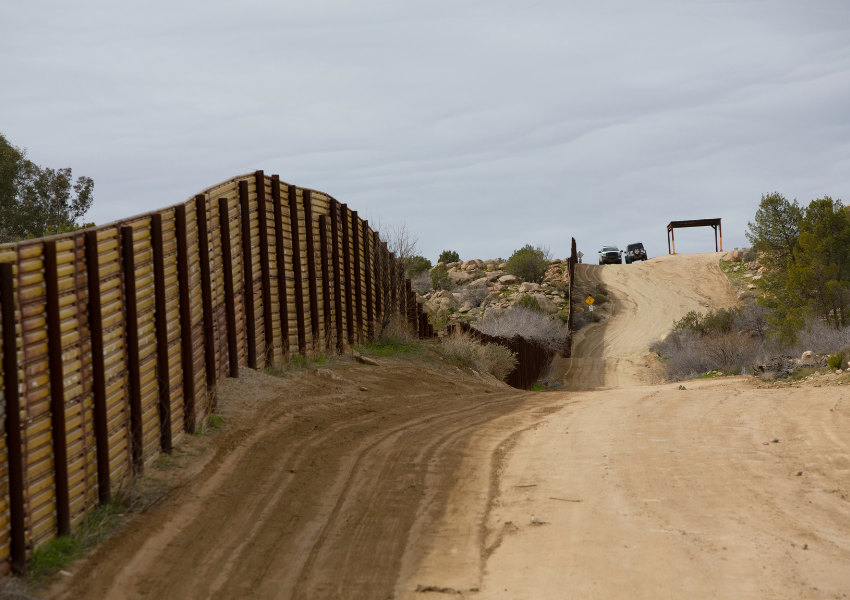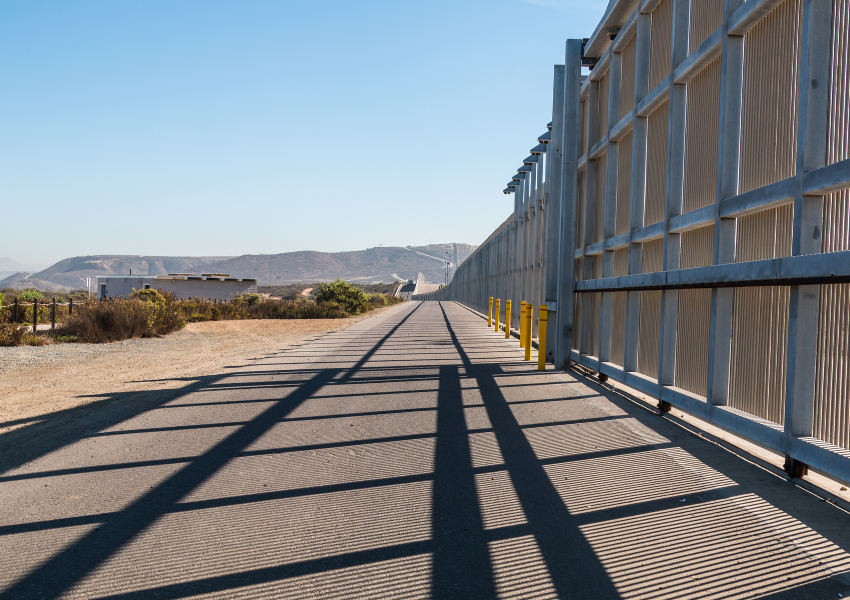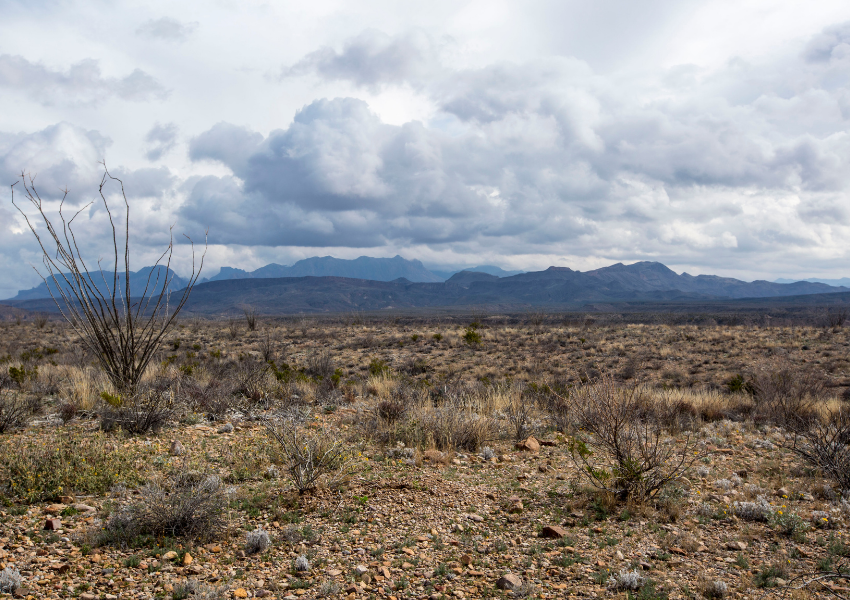NSPM-4: The Border Wall Was Just the Beginning
For years, conservationists, Indigenous leaders, and communities across the Southwest have sounded the alarm about the devastating effects of border wall construction on ecosystems, wildlife, and people. But a far more sweeping threat has now emerged—one that goes beyond walls of steel and concrete.
In January 2025, the Trump administration quietly invoked National Security Presidential Memorandum-4 (NSPM-4) to designate a massive swath of land—170 square miles of federal land in southern New Mexico—as a National Defense Area, transferring control from the Department of the Interior to the Department of Defense. This military takeover—done without Congressional approval—sidesteps foundational environmental protections and represents the largest expansion of military power on U.S. public lands in modern history.
Framed as an effort to “repel an invasion,” this land grab has nothing to do with national safety—and everything to do with power and control. It sets a dangerous precedent, where the Executive Branch can bypass environmental laws like the National Environmental Policy Act (NEPA) and the Endangered Species Act (ESA) under the guise of “national defense.”
Let’s be clear: if the federal government can militarize public lands in the Southwest with no environmental review, it can do the same elsewhere. This is about more than border policy. It’s about the erosion of democratic oversight and the normalization of military control over civilian lands.
 A Threat To Biodiversity And Democracy
A Threat To Biodiversity And Democracy
The lands seized under NSPM-4 are part of one of the most ecologically significant regions in North America: the Chihuahuan Desert, which contains fragile desert ecosystems, transboundary watersheds, and a globally significant biodiversity corridor vital to species like the jaguar, mountain lions, Coues deer, bighorn sheep, Sonoran pronghorn, jaguarundi (if we can ever recover their population), Mexican gray wolf, monarch butterflies, and ferruginous pygmy owls—just to name a few.
Militarizing this area doesn’t just damage ecosystems — it symbolizes a dangerous ideology of division and domination that ignores both science and justice. Previous border wall construction already inflicted massive environmental damage—fragmenting habitats, blocking wildlife migration routes, and turning protected public lands into militarized zones. A 2024 camera study along the Arizona border found an 86% reduction in wildlife crossings in areas with border walls compared to areas with vehicle barriers.
The wide-ranging species listed above need connected habitat to survive and reproduce. Low-flying birds like the ferruginous pygmy owls can’t clear new 30-foot barriers and could be genetically cut off from populations across the border. Monarch butterflies are already deeply threatened by habitat fragmentation and loss that disrupts their multi-generational migration cycle. Border lighting systems and patrol roads create additional harm — disrupting nocturnal wildlife, fragmenting wilderness areas, and increasing mortality through collisions and stress.
The wall divides Tribal nations like the Tohono O’odham, severing cultural and ceremonial routes that predate the U.S. border itself. It cuts off communities from the Rio Grande, limits access to outdoor recreation and spiritual places, and replaces natural beauty with concrete, steel, and surveillance. Migrants are funneled into dangerous terrain where thousands have died — a deliberate policy choice that weaponizes the desert.
Now, NSPM-4 threatens to finish the job: closing off what little habitat connectivity remains and placing these species at further risk while migrants who “trespass” in this zone are disappeared without oversight or recourse—all with zero public accountability. By placing the lands in question under military control, the administration has effectively erased decades of environmental safeguards. The Department of Defense is operating without public oversight or accountability on U.S. soil. Not only is this unheard-of, it’s frighteningly dangerous. NSPM-4 threatens not only wildlife and habitat but also democratic oversight of how our public lands are managed.
NSPM-4 Sets A Dangerous Precedent
NSPM-4 represents the largest expansion of military power on public lands in modern U.S. history. It sets a chilling precedent: that the Executive Branch can invoke emergency powers to override environmental laws and hand control of public lands to the military. Under NSPM-4, the Department of Defense has sweeping authority to conduct operations—including construction, patrols, surveillance, and arrests—without public input or transparency. That means no environmental assessments, no community consultation, and no legal checks on what the military does with our lands.
From Alt National Park Service:
The White House recently issued National Security Presidential Memorandum 4 (NSPM-4), which significantly expands the U.S. military’s involvement in border enforcement along the southern border. While it may appear to be a straightforward national security move, the details raise serious concerns about threats to public lands and civil liberties.
NSPM-4 gives the Department of Defense the authority to take control of federal lands to carry out military operations aimed at “repelling invasions” and “sealing the border.” This includes lands managed by the Department of the Interior and the Department of Agriculture—such as national wildlife refuges, national forests, and other public lands. Indian reservations are excluded, but there are no other geographic limits specified.
The memorandum also gives the Secretary of the Interior the power to override existing legal protections—including those under the Engle Act—allowing emergency withdrawal and restriction of public land use for military purposes without the usual legal oversight.
Why This Matters
– The military can designate these areas as National Defense Areas, closing off public access—possibly for years, or even indefinitely.
– Military personnel are authorized to exclude individuals from these areas and operate under rules of engagement set by the Secretary of Defense. While the memo says actions must comply with the law, it provides little in the way of oversight or accountability.
– Most troubling is the precedent this sets: using “national security” to override environmental protections and civilian control of public lands. Once this power is established, it could easily be applied elsewhere under the broad label of a “national emergency.”
Can Trump legally do this? Maybe—but it’s highly contested. He’s using fringe legal interpretations and emergency powers that stretch existing laws to their limit. Any actual deployment or land seizure under NSPM-4 would almost certainly trigger legal challenges and court battles over civil rights, federalism, and environmental law. Trump (or any president) might be able to deploy the military this way using existing laws, but it is legally questionable and almost certainly challenged in court.
He’s relying on broad, vague powers—like declaring a “national emergency” or labeling immigration as an “invasion”—to justify military action on U.S. soil. While there are some old laws that let the military use public land for defense, they were never meant for routine border enforcement or shutting out the public from them.
So, while he can try to do it under NSPM-4, it’s not clearly legal—and it could easily be stopped by lawsuits or court rulings saying it violates the Constitution or oversteps presidential power.
You can read the full memo on the White House website under the title: “Military Mission for Sealing the Southern Border of the United States and Repelling Invasions.”
 This secrecy is not just undemocratic—it’s dangerous. It erases decades of restoration work, cross-border scientific collaboration, and the hard-fought environmental safeguards that communities and conservation groups have spent years defending.
This secrecy is not just undemocratic—it’s dangerous. It erases decades of restoration work, cross-border scientific collaboration, and the hard-fought environmental safeguards that communities and conservation groups have spent years defending.
If it can happen at the southern border, it can happen anywhere. Borderlands communities—including conservationists, Indigenous leaders, ranchers, and scientists—have long been excluded from decisions about the lands they live on and care for. Now, with military jurisdiction in place, even the pretense of public input has been abandoned.
This isn’t just a border issue—it’s a democratic crisis. An environmental justice crisis. When public lands are militarized, the public loses its voice.
The wall was never just a wall. It was the first move in a larger campaign to undermine science, sideline communities, and consolidate executive power. It reflects a broader ideology—one that sees ecosystems and Indigenous communities as expendable, and treats public land as a battlefield instead of a shared resource. Now, military authority is being used to do what border walls could not: claim control over some of the wildest and most sacred places in America.
We’re Standing Up
At Wildlife for All, we believe that public lands belong to the people—not the Pentagon. That biodiversity is not a political bargaining chip—it is a foundation of life. And the public must have a voice in decisions about land, wildlife, and governance.
We’re demanding:
- The full repeal of NSPM-4 and the return of all seized lands to civilian control.
- Full restoration of environmental protections for borderlands habitats.
- A permanent moratorium on further militarization of public lands.
The border wall was never just about immigration. It was about setting the stage for this kind of unchecked executive power—power that threatens ecosystems, communities, and the very principles of democracy. Let them know you won’t stand for this, either.
 Help Raise The Alarm
Help Raise The Alarm
This isn’t just about a border wall—it’s about unchecked power, disappearing oversight, and ecosystems under siege.
- Share this story. Talk about it. Bring it into the conversation in your community and networks.
- Stay informed. The more people know what’s happening on public lands, the harder it is for this crisis to stay hidden.
- Join us. Follow Wildlife for All and help build a movement that defends wildlife, democracy, and justice for all life.
This Is a Moment for Solidarity
This is not just a southern border issue—it is a national issue. If we don’t resist this normalization of military control, other public lands—national parks, refuges, forests—could be next. We cannot allow emergency powers and fear-mongering to become tools of environmental destruction and democratic erosion.
It’s time to organize, not capitulate. To protect the species like the jaguar and the desert tortoise. To defend cross-border kinship with all humans and the right to wildness. To stand up for democracy, biodiversity, and justice—for all life.
The wall was just the beginning. What we do now will decide what comes next.

